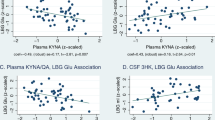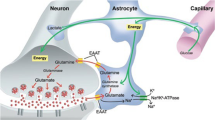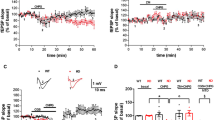Abstract
In 6-hydroxydopamine-lesioned rats, the selective mGlu5 receptor agonist (RS)-2-Cholro-5-Hydroxyphenylglycine (CHPG, 1-6 μg/10 μl intracerebroventricularly) significantly inhibited contralateral turning induced by quinpirole and, to a lesser extent, that induced by SKF 38393. The inhibitory effects of CHPG on quinpirole-induced turning were significantly potentiated by an adenosine A2A receptor agonist (CGS 21680, 0.2 mg/kg IP) and attenuated by an A2A receptor antagonist (SCH 58261, 1 mg/kg IP). In rat striatal membranes, CHPG (100–1,000 nM) significantly reduced the affinity of the high-affinity state of D2 receptors for the agonist, an effect potentiated by CGS 21680 (30 nM). These results show the occurrence of functional interactions among mGlu5, adenosine A2A, and dopamine D2 receptors in the regulation of striatal functioning, and suggest that mGlu5 receptors may be regarded as alternative/integrative targets for the development of therapeutic strategies in the treatment of Parkinson's disease.
Similar content being viewed by others
Log in or create a free account to read this content
Gain free access to this article, as well as selected content from this journal and more on nature.com
or
References
Albin RL, Young AB, Penney JB . (1989): The functional anatomy of basal ganglia disorders. Trends Neurosci 12: 366–375
Alexander GR, Crutcher MD . (1990): Functional architecture and basal ganglia circuits: neural substrates of parallel processing. Trends Neurosci 13: 266–271
Bruton RK, Ge J, Barnes NM . (1999): Group I mGlu receptor modulation of dopamine release in the rat striatum in vivo. Eur J Pharmacol 369: 175–181
Calabresi P, Pisani A, Mercuri NB, Bernardi G . (1996): The corticostriatal projection: from synaptic plasticity to dysfunctions of the basal ganglia. TINS 19: 19–24
Calabresi P, Centonze D, Pisani A, Bernardi G . (1999): Metabotropic glutamate receptors and cell-type-specific vulnerability in the striatum: implication for ischemia and Huntington's disease. Exp Neurol 158: 97–108
Carlsson M, Carlsson A . (1990): Interactions between glutamatergic and monoaminergic systems within the basal ganglia—implications for schizophrenia and Parkinson's disease. TINS 13: 272–276
Corsi C, Melani A, Bianchi L, Pepeu G, Pedata F . (1999): Striatal A2A receptors differentially regulate spontaneous and K+-evoked glutamate release in vivo in young and aged rats. NeuroReport 10: 687–691
Doherty AJ, Palmer MJ, Henley JM, Collingridge GL, Jane DE . (1997): (RS)-2-cholro-5-hydroxyphenylglycine (CHPG) activates mGlu5, but not mGlu1, receptors expressed in CHO cells and potentiates NMDA responses in the hippocampus. Neuropharmacology 36: 265–267
Ferré S, Von Euler G, Johansson B, Fredholm B, Fuxe K . (1991): Stimulation of high-affinity adenosine A-2 receptors decreases the affinity of dopamine D-2 receptors in rat striatal membranes. Proc Natl Acad Sci USA 88: 7238–7241
Ferré S, O'Connor WT, Fuxe K, Ungerstedt U . (1993): The striopallidal neuron: a main locus for adenosine–dopamine interactions in the brain. J Neurosci 13: 5402–5406
Ferré S, Fredholm BB, Morelli M, Popoli P, Fuxe K . (1997): Adenosine-dopamine receptor-receptor interactions as an integrative mechanism in the basal ganglia. TINS 20: 482–487
Ferré S, Popoli P, Rimondini R, Reggio R, Kehr J, Fuxe K . (1999): Adenosine A2A and group I metabotropic glutamate receptors synergistically modulate the binding characteristics of dopamine D2 receptors in the rat striatum. Neuropharmacology 38: 129–140
Fink JS, Weaver DR, Rivkees SA, Peterfreund RA, Pollack A, Adler DM, Reppert SM . (1992): Molecular cloning of the rat A2 adenosine receptors: selective co-expression with D2 dopamine receptors in rat striatum. Mol Brain Res 14: 186–195
Garrett BE, Holtzman SG . (1994): Caffeine cross-tolerance to the selective dopamine D1 and D2 receptor agonists but not to their synergistic interaction. Eur J Pharmacol 262: 65–75
Garrett BE, Holtzman SG . (1995): The effects of dopamine agonists on rotational behavior in nontolerant and caffeine-tolerant rats. Behav Pharmacol 6: 843–851
Gasparini F, Lingenhöhl K, Stoehr N, Flor PJ, Heinrich M, Vranesic I, Biollaz M, Allgeier H, Heckendorn R, Urwyeler S, Varney MA, Johnson EC, Hess SD, Rao SP, Sacaan AI, Santori EM, Veliçelebi G, Kuhn R . (1999): 2-Methyl-6-(phenylethynyl)-pyridine (MPEP), a potent, selective, and systemically active mGlu5 receptor antagonists. Neuropharmacology 38: 1493–1503
Gerfen CR, Engber TM, Mahan L, Susel Z, Chase TN, Monsma FJ, Sibley DR . (1990): D1 and D2 dopamine receptor-regulated gene expression of strionigral and striopallidal neurons. Science 250: 1429–1432
Kaatz KW, Albin RL . (1995): Intrastriatal and intrasubthalamic stimulation of metabotropic glutamate receptors: A behavioral and FOS immunohistochemical study. Neuroscience 66: 55–65
Kearney JAF, Albin RL . (1995): Adenosine A2 receptor-mediated modulation of contralateral rotation induced by metabotropic glutamate receptor activation. Eur J Pharmacol 287: 115–120
Kearney JAF, Frey KA, Albin RL . (1997): Metabotropic glutamate agonist-induced rotation: a pharmacologic, FOS immunohistochemical and [14C]-2-deoxyglucose autoradiographic study. J Neurosci 17: 4415–4425
Kearney JAF, Becker JB, Frey KA, Albin RL . (1998): The role of nigrostriatal dopamine in metabotropic glutamate agonist-induced rotation. Neuroscience 87: 881–891
Kronthaler UO, Schmidt WJ . (1996): 1S-3R-ACPD has cataleptogenic effects and reverses MK-801 and less pronounced, d,l-amphetamine-induced locomotion. Eur J Pharmacol 316: 129–136
Lipton SA, Rosenberg PA . (1994): Excitatory amino acid as a final common pathway for neurologic disorders. N Engl J Med 330: 613–622
Pintor A, Potenza RL, Domenici MR, Tiburzi F, Reggio R, Pèzzola A, Popoli P . (2000): Age-related decline in the functional response of striatal group I mGlu receptors. NeuroReport 11: 3033–3038
Popoli P, Reggio R, Pèzzola A . (2000): Effects of SCH 58261, an adenosine A2A receptor antagonist, on quinpirole-induced turning in 6-hydroxydopamine-lesioned rats: lack of tolerance after chronic caffeine intake. Neuropsychopharmacology 22: 522–529
Rimondini R, Fuxe K, Ferré S . (1999): Multiple intramembrane receptor–receptor interactions in the regulation of striatal dopamine D2 receptors. NeuroReport 10: 2051–2054
Romano C, Sesma MA, McDonald CT, O'Malley K, Van Den Pol AN, Olney JW . (1995): Distribution of metabotropic glutamate receptor mGluR5 immunoreactivity in rat brain. J Comp Neurol 355: 455–469
Sacaan AI, Bymaster FP, Schoepp DD . (1992): Metabotropic glutamate receptor activation produces extrapyramidal motor system activation that is mediated by striatal dopamine. J Neurochem 59: 245–251
Schiffmann SN, Jacobs O, Vanderhaeghen J-J . (1991): Striatal restricted adenosine A2 receptor (RDC8) is expressed by enkephalin but not by substance P neurons: an in situ hybridization histochemistry study. J Neurochem 57: 1062–1067
Schwarting PKW, Huston JP . (1996): The unilateral 6-hydroxydopamine lesion model in behavioral brain research. Analysis of functional deficits, recovery, and treatments. Prog Neurobiol 50: 275–331
Smith ID, Beninger RJ . (1996): Contralateral turning caused by metabotropic glutamate receptor stimulation in the dorsal striatum is reversed by MCPG, TTX, and cis-Flupenthixol. Behav Neurosci 110: 282–289
Starr MS . (1995): Glutamate/dopamine D1/D2 balance in the basal ganglia and its relevance to Parkinson's disease. Synapse: 264–293
Starr MS, Starr BS, Kaur S . (1997): Stimulation of basal and L-DOPA-induced motor activity by glutamate antagonists in animal models of Parkinson's disease. Neurosci Biobehav Rev 21: 437–446
Svenningsson P, Le Moine C, Kull B, Sunahara R, Bloch B, Fredholm BB . (1997): Cellular expression of adenosine A2A receptor messenger RNA in the rat central nervous system with special reference to dopamine innervated areas. Neuroscience 80: 1171–1185
Tallaksen-Greene SJ, Kaatz KW, Romano C, Albin RL . (1998): Localization of mGluR1α-like immunoreactivity and mGlur5-like immunoreactivity in identified populations of striatal neurons. Brain Res 780: 210–217
Testa CM, Standaert DG, Young AB, Penney JB . (1994): Metabotropic glutamate receptor mRNA expression in the basal ganglia of the rat. J Neurosci 14: 3005–3018
Testa CM, Standaert DG, Landwehrmeyer GB, Penney JB, Young AB . (1995): Differential expression of mGluR5 metabotropic glutamate receptor mRNA by rat striatal neurones. J Comp Neurol 354: 241–252
Ungerstedt U . (1971): Postsynaptic supersensitivity after 6-hydroxydopamine induced degeneration of the nigrostriatal dopamine system in the rat brain. Acta Physiol Scand 82(Suppl. 367):69–93
Vezina P, Kim J-H . (1999): Metabotropic glutamate receptors and the generation of locomotor activity: interactions with midbrain dopamine. Neurosci Biobehav Rev 23: 577–589
Acknowledgements
The support from Glaxo (Verona, Italy) to M.T., K.F., and S.F. is gratefully acknowledged. This work was supported in part by the National Parkinson Foundation, Inc. (grant to K.F.).
Author information
Authors and Affiliations
Corresponding author
Rights and permissions
About this article
Cite this article
Popoli, P., Pèzzola, A., Torvinen, M. et al. The Selective mGlu5 Receptor Agonist CHPG Inhibits Quinpirole-Induced Turning in 6-Hydroxydopamine-Lesioned Rats and Modulates the Binding Characteristics of Dopamine D2 Receptors in the Rat Striatum Interactions with Adenosine A2a Receptors. Neuropsychopharmacol 25, 505–513 (2001). https://doi.org/10.1016/S0893-133X(01)00256-1
Received:
Revised:
Accepted:
Published:
Issue date:
DOI: https://doi.org/10.1016/S0893-133X(01)00256-1
Keywords
This article is cited by
-
Adenosine A2A receptor inhibition reduces synaptic and cognitive hippocampal alterations in Fmr1 KO mice
Translational Psychiatry (2021)
-
The coming together of allosteric and phosphorylation mechanisms in the molecular integration of A2A heteroreceptor complexes in the dorsal and ventral striatal-pallidal GABA neurons
Pharmacological Reports (2021)
-
Purinergic Receptors in Basal Ganglia Diseases: Shared Molecular Mechanisms between Huntington’s and Parkinson’s Disease
Neuroscience Bulletin (2020)
-
Decrease of mGluR5 receptor density goes parallel with changes in enkephalin and substance P immunoreactivity in Huntington’s disease: a preliminary investigation in the postmortem human brain
Brain Structure and Function (2015)
-
Sleep Homeostasis, Metabolism, and Adenosine
Current Sleep Medicine Reports (2015)



